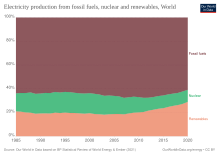User:Clayoquot/Nuclear
Nuclear power[edit]

Nuclear power plants have been used since the 1950s as a low-carbon source of baseload electricity.[2] Nuclear power plants in over 30 countries generate about 10% of global electricity.[3] As of 2019, nuclear generated over a quarter of all low-carbon energy, making it the second largest source after hydropower.[4]
Nuclear power's lifecycle greenhouse gas emissions—including the mining and processing of uranium—are similar to the emissions from renewable energy sources.[5] Nuclear power uses little land per unit of energy produced, compared to the major renewables,[6] and does not create local air pollution.[7] The uranium ore used to fuel nuclear fission plants is a non-renewable resource, but sufficient quantities exist to provide a supply for hundreds to thousands of years.[8][9] Climate change mitigation pathways consistent with ambitious goals typically see an increase in power supply from nuclear.[10]
There is controversy over whether nuclear power is sustainable.[11] Radioactive nuclear waste must be managed over multi-generation timescales[12] and nuclear power plants can create fissile material that could be used for nuclear weapon proliferation.[12] For each unit of energy produced, nuclear energy has caused far fewer accidental and pollution-related deaths than fossil fuels, and the historic fatality rate of nuclear is comparable to renewable sources.[13] Public opposition to nuclear energy often makes nuclear plants politically difficult to implement.[12]
Reducing the time and the cost of building new nuclear plants have been goals for decades but progress has been limited.[14][15] Various new forms of nuclear energy are in development, hoping to address the drawbacks of conventional plants. Fast breeder reactors are capable of recycling nuclear waste and therefore can significantly reduce the amount of waste that requires geological disposal, but have not yet been deployed on a large-scale commercial basis.[16] Nuclear power based on thorium (rather than uranium) may be able to provide higher energy security for countries that do not have a large supply of uranium.[17] Small modular reactors may have several advantages over current large reactors: It should be possible to build them faster and their modularization would allow for cost reductions via learning-by-doing.[18] Several countries are attempting to develop nuclear fusion reactors, which would generate small amounts of waste and no risk of explosions.[19]
- ^ Roser, Max (10 December 2020). "The world's energy problem". Our World in Data. Retrieved 2021-07-21.
{{cite web}}: CS1 maint: url-status (link) - ^ Rhodes, Richard (19 July 2018). "Why Nuclear Power Must Be Part of the Energy Solution". Yale E360. Retrieved 2021-07-24.
{{cite web}}: CS1 maint: url-status (link) - ^ "Nuclear Power in the World Today". World Nuclear Association. June 2021. Archived from the original on 16 July 2021. Retrieved 19 July 2021.
- ^ Ritchie, Hannah; Roser, Max (2020). "Energy mix". Our World in Data. Archived from the original on 2 July 2021. Retrieved 9 July 2021.
- ^ Schlömer, S.; Bruckner, T.; Fulton, L.; Hertwich, E. et al. "Annex III: Technology-specific cost and performance parameters". In IPCC (2014), p. 1335. Harvc error: no target: CITEREFIPCC2014 (help)
- ^ Van Zalk, John; Behrens, Paul (2018). "The spatial extent of renewable and non-renewable power generation: A review and meta-analysis of power densities and their application in the U.S." Energy Policy. 123: 83–91. doi:10.1016/j.enpol.2018.08.023. ISSN 0301-4215.
- ^ Ritchie, Hannah; Roser, Max (2020). "Nuclear Energy". Our World in Data. Retrieved 19 July 2021.
- ^ MacKay 2008, p. 162.
- ^ Gill, Matthew; Livens, Francis; Peakman, Aiden. "Nuclear Fission". In Letcher (2020), p. 135. Harvc error: no target: CITEREFLetcher2020 (help)
- ^ IPCC SR15 2018, 2.4.2.1.
- ^ Kessides, I. N. (2010). "Nuclear Power and Sustainable Energy Policy: Promises and Perils". The World Bank Research Observer. 25 (2): 323–362. doi:10.1093/wbro/lkp010. ISSN 0257-3032.
- ^ a b c Gill, Matthew; Livens, Francis; Peakman, Aiden. "Nuclear Fission". In Letcher (2020), pp. 147–149. Harvc error: no target: CITEREFLetcher2020 (help)
- ^ Ritchie, Hannah (10 February 2020). "What are the safest and cleanest sources of energy?". Our World in Data. Archived from the original on 29 November 2020. Retrieved 2 December 2020.
- ^ Timmer, John (21 November 2020). "Why are nuclear plants so expensive? Safety's only part of the story". arstechnica. Archived from the original on 28 April 2021. Retrieved 17 March 2021.
- ^ Dunai, Marton; De Clercq, Geert (24 September 2019). "Nuclear energy too slow, too expensive to save climate: report". Reuters. Archived from the original on 16 March 2021. Retrieved 2021-03-18.
- ^ European Commission Joint Research Centre (2021). Technical assessment of nuclear energy with respect to the 'do no significant harm' criteria of Regulation (EU) 2020/852 ('Taxonomy Regulation') (PDF) (Report). p. 53. Archived (PDF) from the original on 26 April 2021. Retrieved 30 June 2021.
- ^ Gill, Matthew; Livens, Francis; Peakman, Aiden. "Nuclear Fission". In Letcher (2020), pp. 146–147. Harvc error: no target: CITEREFLetcher2020 (help)
- ^ Locatelli, Giorgio; Mignacca, Benito. "Small Modular Nuclear Reactors". In Letcher (2020), pp. 151–169. Harvc error: no target: CITEREFLetcher2020 (help)
- ^ McGrath, Matt (2019-11-06). "Nuclear fusion is 'a question of when, not if'". BBC News. Archived from the original on 25 January 2021. Retrieved 13 February 2021.
